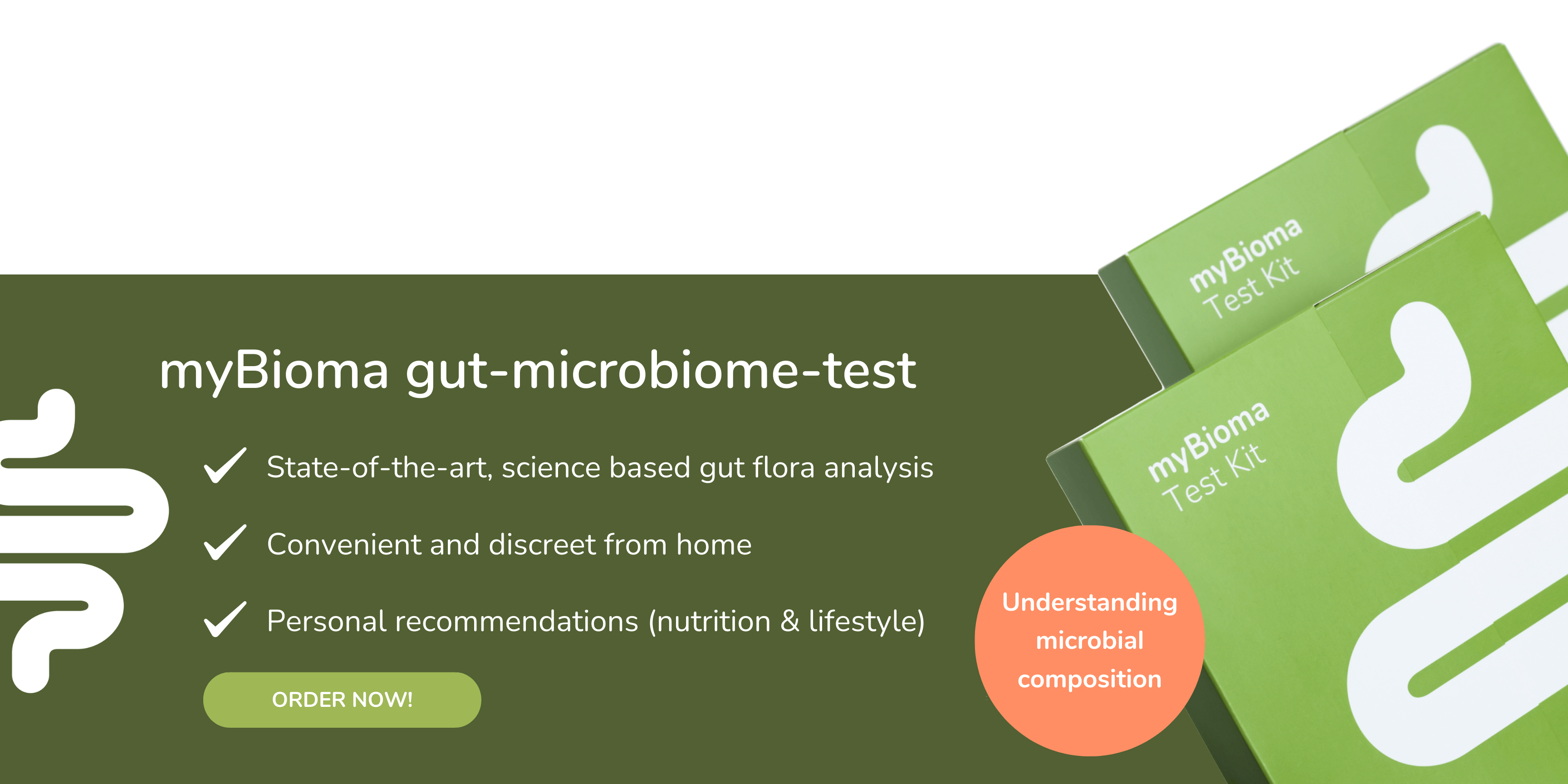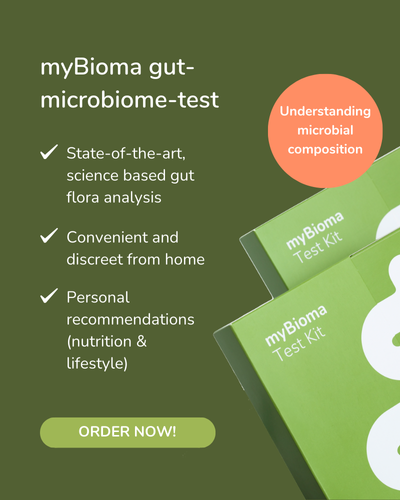Table of contents
- Stress - an underestimated threat to our health
- The enteric nervous system: Our “second brain” in the belly
- The vagus nerve: A central component of the gut-brain axis
- How the gut microbiome influences our brain
- The effects of stress on your gut health
- Regulating the nervous system with mindfulness
- Practical exercises to stimulate the vagus nerve and effectively reduce stress
- Breathing exercises
- Meditation
- Mindful eating
- Conclusion: Listen to your gut feeling
Stress, inner restlessness, digestive issues – many people experience on a daily basis just how closely the body and mind are connected. The gut plays a key role in this relationship. It is home to countless bacteria (referred to as the gut flora or gut microbiome), which are involved in the production of signalling molecules such as neurotransmitters. Through the so-called gut-brain axis – and particularly via the vagus nerve – our gut and brain are in constant, two-way communication. In other words: your gut influences your mental well-being – and your brain influences your digestion. In this article, you’ll learn how mindfulness exercises can help regulate your nervous system, promote relaxation, and ease digestive complaints.
Stress - an underestimated threat to our health
The World Health Organization has declared stress one of the greatest health threats of the 21st century. While we no longer have to flee from tigers, psychosocial causes of stress are on the rise. These constantly activate our nervous system, making us more vulnerable to a variety of stress-related illnesses (1).
The meaning of stress and why you are probably affected (consciously or subconsciously)
Stress is a natural response of the body to internal or external pressure. When we’re faced with a challenge – whether it’s an important presentation, a personal conflict, or simply the pressure of a busy schedule – our body releases stress hormones like adrenaline and cortisol. These hormones activate the sympathetic nervous system, preparing us for the so-called “fight or flight” response.
Acute stress, which occurs only temporarily, is generally not harmful. In fact, it helps us respond quickly in critical situations and boosts our performance. However, it is essential that a period of relaxation follows, during which the parasympathetic nervous system (our rest and digest mode) becomes active.
When stress becomes a permanent burden
If our stress levels remain elevated over a longer period, it’s referred to as chronic stress. This can result from ongoing overload at work, pressure to perform, perfectionism, unresolved emotional conflicts, constant availability, or the persistent (often unconscious) comparison with others on social media.
This type of stress has not only psychological but also physical effects. Headaches, digestive problems, increased susceptibility to infections, elevated inflammation levels, and sleep disturbances are just some of the physical symptoms associated with chronic stress. Unfortunately, these warning signals from our body are often overlooked - either because we perceive them as "normal" or don't associate them with stress.
For our body, mental threats feel just as real as external ones
Whether it's an infection, physical overexertion, extreme heat, emotional pain or anxiety about the future – every form of stress triggers the same biological response patterns (2). Our body doesn’t make a big distinction between fighting a virus, feeling emotionally hurt by a message or when having a stressful morning. It responds with the same stress cascade, primarily regulated by the HPA axis (hypothalamic-pituitary-adrenal axis).
This involves the release of stress hormones like cortisol and adrenaline – which leads to increased heart rate and breathing, elevated blood sugar levels, and a suppression of digestive function and immune activity (2).
Interestingly, elevated cortisol levels can also occur when people close to us are stressed. This is known as an empathic stress response (1).
The good news: You can turn the tables
We can also take advantage of the fact that our body can hardly distinguish whether a danger is real or "only mental" – by training our mind and actively guiding our nervous system back into relaxation mode. Through mindfulness breaks during the day, breathing exercises, or meditation, our nervous system can learn to return to balance more quickly.
But more on that later – first let’s take a look at what our gut actually has to do with all of this.
The enteric nervous system: Our “second brain” in the belly
Our intestines are interwoven with a vast network of nerves: the enteric nervous system (ENS) – also known as the "gut brain." It consists of several million nerve cells (more than in our spinal cord!) and is responsible for many vital functions in the digestive tract: It regulates, among other things, intestinal motility, the permeability of the intestinal barrier, and the immune system in the gut.
Furthermore, the intestinal nervous system is directly connected to our autonomic nervous system, the part of our nervous system that functions without conscious control - e.g., heartbeat or breathing. The autonomic nervous system consists of two counterparts, which were already mentioned: the sympathetic nervous system ("fight or flight" mode: activation and performance) and the parasympathetic nervous system ("rest and digest" mode: relaxation, digestion, and recovery).
The vagus nerve: A central component of the gut-brain axis
The vagus nerve is the main nerve of our parasympathetic nervous system and also the longest cranial nerve (3). It connects the brain to the internal organs – including your gut. You can imagine it as a bidirectional data highway between the brain and the gut. It transmits information to the brain about what is currently happening in the digestive tract and, conversely, sends signals from the brain to the gut – especially when it’s time to relax and digest. Due to its important role in initiating regeneration and recovery, the vagus nerve is sometimes referred to as the "self-healing nerve."

Simplified graphic: The vagus nerve is the longest cranial nerve and connects the brain to the internal organs. It is thus a central component of the gut-brain axis and ensures relaxation, regeneration, and good digestion.
Long story short: When you're stressed, your gut also "feels" the stress. This explains why many people can't eat, get constipated, need to go to the bathroom more often, or feel nauseous when they're nervous.
How the gut microbiome influences our brain
Another important piece of the gut-brain axis puzzle is the microbiome (also known as the gut flora). The community of billions of microorganisms in our gut has a significant influence on our mood, our psychological well-being, and our ability to cope with stress. For example, various studies have shown that people with depression have a different microbiome composition than healthy individuals. You can read more about it in this article: Depression & gut: The role of the microbiome
The bacteria in your gut communicate with the nervous system, for example, by producing important short-chain fatty acids and by participating in the production or activation of important messenger substances such as hormones and neurotransmitters. These include (4):
- Serotonin: Up to 90% of the so-called “happiness hormone” is produced in the gut.
- GABA (gamma-aminobutyric acid): Sends calming signals to our nervous system and thus helps us to relax and feel more calm.
- Dopamine: Supports motivation and drive and gives us a feeling of euphoria when we have achieved something.
If the microbiome becomes unbalanced - for example, due to chronic stress, an unbalanced diet, or antibiotics - the signaling between the gut and brain can become disrupted. The result: mood swings, anxiety, sleep disturbances, or an increased susceptibility to stress and infections. A vicious cycle begins – raising the old question: what came first – the chicken (mental well-being) or the egg (a balanced microbiome)?
The key takeaway: By taking care of your gut and supporting your intestinal bacteria with a fibre-rich, balanced diet, you can actively support your emotional balance and stress resilience .
Want to find out whether your gut microbiome is in balance and what steps you can take to support your gut health? Then order a myBioma microbiome-test today and gain easy, science-based insights into your gut.
The effects of stress on your gut health
Stress is increasingly recognized as a significant factor in the development of many intestinal diseases - and stress-related diseases are often associated with impaired intestinal function.
Among other things, stress has the following effects on your gut and your microbiome (3):
Acute stress (lasting less than one hour):
- Altered bowel movements – which can manifest as bloating, constipation or diarrhea, for example.
- Activation of the immune system - a helpful and important short-term response in the case of injury or infection.
Prolonged or chronic stress:
- Increased perception of abdominal pain (visceral hypersensitivity) – a key factor in in irritable bowel syndrome.
- Reduced attention and ability to concentrate.
- Low mood and increased risk of mental health issues.
- Impaired vagus nerve signalling – communication between the gut and brain becomes less effective.
- Altered bowel movements – constipation, diarrhea or bloating may occur.
- Increased intestinal permeability - leading to increased inflammation. For more information, take a look at this blog post: Leaky Gut – and Why a Healthy Gut Barrier Matters
- Microbiome imbalance: Beneficial bacteria are decreasing, while potentially harmful ones are increasing, which is referred to as dysbiosis. The microbiome becomes less diverse and less resilient. You can learn more about this in this blog post: How to increase diversity and avoid dysbiosis.
- The immune system is overwhelmed and becomes unbalanced – susceptibility to pathogens and infections increases.
Regulating the nervous system with mindfulness
So what can you do to better manage stress, regulate your nervous system, and activate the parasympathetic system – particularly the vagus nerve? Let’s begin with a well-known quote by Marcus Aurelius:
“The happiness of your life depends on the quality of your thoughts.”
It's not always easy to reduce stress in everyday life. What we can influence, however, is how we deal with stressful situations. As you already know, our nervous system can't distinguish whether we're actually in danger or whether the stress stimuli are "just" occurring in our thoughts. Conversely, this also means that we can counteract stress with the power of our thoughts and the active regulation of bodily functions (keyword: breathing). In other words, we use these mechanisms for ourselves, rather than against us. Very effective and accessible tools for this are mindfulness practices.

Mindfulness can help you internalise this mindset and return to a state of inner calm more easily.
What is mindfulness?
Mindfulness means consciously perceiving the present moment - with everything that's present: thoughts, feelings, bodily sensations. Without judgement or comparison, but with acceptance and a neutral, open awareness.
The concept originates from Buddhist meditation practices and encompasses not only awareness, but also emotional, ethical, and social aspects.
In modern psychology, mindfulness is primarily applied through structured programmes such as MBSR (Mindfulness-Based Stress Reduction) – for example, in stress management, pain reduction, or the treatment of mental health conditions (5). There’s also growing evidence supporting its effectiveness in managing irritable bowel syndrome (IBS) (6).
Despite different origins, both perspectives show that mindfulness can help us live a more conscious, calmer and healthier life.
How mindfulness activates the vagus nerve – and why you should take advantage of it
Mindfulness - particularly in the form of meditation, conscious breathing, or mindful yoga exercises - can naturally activate the vagus nerve and reduce stress. Researchers have found that mindful breathing techniques and meditative states increase heart rate variability (HRV) - a sign of increased vagus nerve activity. At the same time, mindfulness can reduce the release of stress hormones such as cortisol and adrenaline, which contributes to faster recovery from stressful situations. Various studies also show that meditation practices can also reduce other physiological stress markers, such as C-reactive protein, blood pressure, heart rate, triglycerides, and tumor necrosis factor-alpha (7,8).
Regular mindfulness practice can activate the parasympathetic nervous system, calm the body's stress response, reduce inflammation, and enhance overall well-being. A mindful lifestyle thus supports not only emotional balance but also physical health.
Thanks to its anti-inflammatory effects, vagus nerve stimulation may also be beneficial in the prevention or treatment of various diseases, such as rheumatoid arthritis, lung conditions, obesity, diabetes, stroke, brain injuries, and cardiovascular problems. Targeted vagus nerve activation has also been successfully used as a complementary therapeutic approach for epilepsy and depression. In clinical settings, small devices are usually used that deliver electrical impulses to the vagus nerve via an electrode (9).
Practical exercises to stimulate the vagus nerve and effectively reduce stress
After all the theory, we now come to the most important part: the practice! We'll introduce you to effective and simple measures for regulating your nervous system and getting into relaxation mode.
Breathing exercises
On the one hand, breathing happens completely automatically - on the other, we can also consciously influence our breathing. This makes it one of the simplest tools for reducing stress.
➡️ Fast, shallow breathing activates the sympathetic nervous system – just like in stress.
➡️ Slow, deep breathing activates the parasympathetic nervous system – we calm down, our pulse drops, and our brain receives the signal: activate regeneration and digestion.
1. Box breathing
This simple and structured breathing technique helps you calm down and stop the mental chatter. The best way to begin is in an upright seated position.
- Breathe in through your nose, counting to 4. Feel your belly rise.
- Hold your breath, counting to 4.
- Breathe out gently through your nose or mouth, counting to 4 again. Feel your belly sink down again.
- Hold your breath again, counting to 4.
Repeat this cycle for a few minutes.

2. The 4-7-8 breathing
This gentle breathing technique involves prolonging the exhalation – which can be particularly helpful in cases of inner restlessness and can make it easier to fall asleep at night.
- Inhale through your nose for 4 seconds.
- Hold your breath for 7 seconds.
- Exhale through your nose or mouth for 8 seconds.
Repeat the cycle for about 5 rounds – either lying down or sitting upright.
Tip: If holding the breathing pause feels too long, begin with half the duration for each breathing section and slowly extend the times as it becomes more comfortable.
Meditation
Regular meditation practice – for example in the morning after waking up or in the evening before going to bed – helps you arrive in the present moment and reconnect with yourself. Meditation is much more than just an attempt to "think of nothing". It's a mental and neurological training that, over time, has been scientifically shown to reduce stress, improve focus, and even have positive effects on digestion and the gut microbiome.

Meditation can help you achieve inner peace.
There are countless types of meditation. We'd like to introduce you to three of them:
1. Concentration meditation: Observing the breath
- Sit comfortably and upright – for example, cross-legged, in kneeling position or on a chair – and gently close your eyes.
- Bring your attention to your breath – without changing it.
- Feel the air flowing in and out through your nose.
- If you notice thoughts coming up, observe them consciously without judgement. Let them pass – as if you were watching clouds in the sky. Gently bring your attention back to your breath.
Start with 5 minutes a day and increase the duration over time. Regularity is more important than duration - don't put pressure on yourself.
Tip: It's completely normal and okay for thoughts to keep popping up. The goal isn't to shut down all thoughts. Rather, we want to practice not letting them control us. Be kind and patient with yourself. 💚
2. Body scan
In this mindfulness exercise, we systematically move our attention through the body.
- Lie comfortably on your back or sit upright and gently close your eyes.
- Direct your attention to your toes, feet, legs, pelvis, abdomen, chest area, back, shoulders, arms, hands, fingers, neck, head and face – one by one.
- Stay in each area for a few breaths and notice all parts and sensations of your body without judging them: temperature, tension, tingling, lightness, etc.
Tip: A guided meditation can be very helpful, especially at the beginning. Simply search on Spotify or YouTube for a voice you find pleasant, or try out a meditation app.
3. Gut-directed hypnotherapy
A special type of guided meditation is gut-directed hypnotherapy. This technique is particularly well-known for its positive effects on irritable bowel syndrome. If you’d like to learn more, check out this blog article: Mindfulness for the gut: How effective hypnosis is for IBS
Mindful eating
Perhaps the most important times in our daily lives to practice mindfulness are during our meals. Mindful eating allows us to better perceive our body's signals, such as our sense of satiety. Digestion actually begins in the mouth: by chewing thoroughly and consciously, food is mechanically broken down and mixed with enzymes in the saliva. This relieves the stomach and intestines, improves nutrient absorption, supports healthy gut function and helps prevent bloating. In addition, we activate our “rest & digest” nervous system mode and support the gut-brain axis.
1. Tips for mindful eating:
✅ No distractions: Put your phone away and avoid watching your favorite series while eating.
✅ Chew thoroughly and eat slowly: Try to chew each bite 20-30 times.
✅ Savour mindfully: Notice the flavors, texture and smell of your meal.
✅ Listen to your body: Pay attention to hunger and satiety signals and stop eating when you are full.
✅ Practice gratitude and appreciation: Become aware of where your food comes from and how much work goes into each bite.
✅ Put down your cutlery every now and then to automatically eat more slowly.
2. Raisin exercise
The raisin exercise is a classic mindfulness practice that helps us experience the present moment with all of our senses. All you need is a single raisin, or alternatively, a piece of chocolate, a nut, or a berry.
- Look:
Hold the raisin in your hand and curiously examine it from all sides, as if you've never seen a raisin before. What color is it? What shape? What wrinkles and bumps do you notice? - Touch:
Feel the texture between your fingers. Is it sticky, firm, wrinkled, or soft? Take your time to truely "grasp" it. - Smell:
Hold the raisin to your nose. What do raisins actually smell like? Observe whether the smell evokes other associations or memories - without judging them. - Listen:
Sounds odd, but now hold the raisin up to your ear. Even if it doesn’t speak to you 😉 – activate your sense of hearing. Rub it between your fingers or gently scratch it with your nails – what sounds do you notice? - Put in your mouth:
Place the raisin on your tongue and carefully move it around your mouth. What does it feel like? Where exactly is it located in your mouth? - Chew slowly:
Now begin to chew slowly, noticing the texture and taste of the raisin. How does the experience change with each chew? How long can you nibble on the raisin until it almost dissolves? - Swallow and reflect:
Consciously swallow the chewed raisin. Tune in: How does your mouth feel now? What sensations remain?
If you've tried any of these tips or would like to share your favorite mindfulness practice with us, please leave us a comment at the end of the blog! ⬇️
Conclusion: Listen to your gut feeling
Our gut and brain are constantly communicating with each other and influence each other in a variety of ways. Chronic stress can weaken this sensitive and important communication, thus impairing our health and well-being.
The good news: We're not powerless. With simple exercises for more inner peace, we can actively contribute to balancing our gut-brain axis and our nervous system - and thus find greater well-being, resilience, and joy in life. Small, daily steps can have a big impact! Give it a go and see for yourself. ✨
One final note: These exercises can be a helpful support along the way. If you’ve not been feeling well for a longer period, don’t hesitate to seek professional help. You’re not alone – and reaching out for support shows real strength. Take care of yourself! 💚
References
- Engert V. Max Planck Institute for Human Cognitive and Brain Sciences. [Cited April 29, 2025]. Research Group Social Stress and Family Health. Available at: https://www.cbs.mpg.de/selbststaendige-forschungsgruppen/social-stress-and-family-health
- Bellavance MA, Rivest S. The HPA – Immune Axis and the Immunomodulatory Actions of Glucocorticoids in the Brain. Front Immunol. March 31, 2014;5:136.
- Leigh SJ, Uhlig F, Wilmes L, Sanchez-Diaz P, Gheorghe CE, Goodson MS, et al. The impact of acute and chronic stress on gastrointestinal physiology and function: a microbiota–gut–brain axis perspective. The Journal of Physiology. 2023;601(20):4491–538.
- Cryan JF, O'Riordan KJ, Cowan CSM, Sandhu KV, Bastiaanssen TFS, Boehme M, et al. The Microbiota-Gut-Brain Axis. Physiological Reviews. October 2019;99(4):1877–2013.
- Grossman P. Practicing Mindfulness: A Unique Clinical Intervention for the Behavioral Sciences. In: Mindfulness and Acceptance in Psychotherapy. A Handbook. Tübingen: dgvt-Verlag; 2005.
- Layer P, Andresen V, Allescher H, Bischoff SC, Claßen M, Elsenbruch S, et al. Update S3 guideline on irritable bowel syndrome: definition, pathophysiology, diagnostics, and therapy. Joint guideline of the German Society for Gastroenterology, Digestive and Metabolic Diseases (DGVS) and the German Society for Neurogastroenterology and Motility (DGNM) – June 2021 – AWMF registration number: 021/016. Z Gastroenterol. December 2021;59(12):1323–415.
- Brown L, Rando AA, Eichel K, Van Dam NT, Celano CM, Huffman JC, et al. The Effects of Mindfulness and Meditation on Vagally-Mediated Heart Rate Variability: A Meta-Analysis. Psychosom Med. 2021;83(6):631–40.
- Gerritsen RJS, Volume GPH. Breath of Life: The Respiratory Vagal Stimulation Model of Contemplative Activity. Front Hum Neurosci. October 9, 2018;12:397.
- Johnson RL, and Wilson CG. A review of vagus nerve stimulation as a therapeutic intervention. Journal of Inflammation Research. May 16, 2018;11:203-13.







